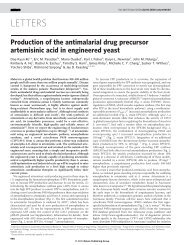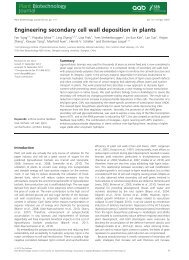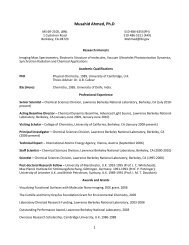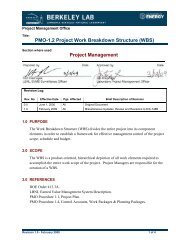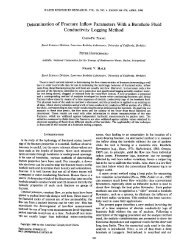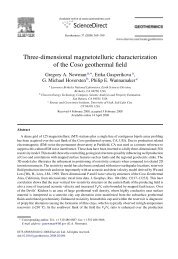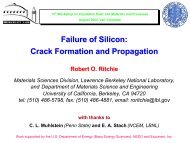structure of the ribosome
structure of the ribosome
structure of the ribosome
You also want an ePaper? Increase the reach of your titles
YUMPU automatically turns print PDFs into web optimized ePapers that Google loves.
to an increased effort to improve methods for<br />
RNA crystallization (15). An encouraging sign<br />
was <strong>the</strong> appearance <strong>of</strong> <strong>the</strong> first crystal <strong>structure</strong>s <strong>of</strong> a<br />
catalytic RNA, <strong>the</strong> hammerhead ribozyme, solved<br />
first as an RNA-DNA chimera and subsequently<br />
as an all-RNA <strong>structure</strong> (3, 4). Both <strong>structure</strong>s<br />
revealed essentially <strong>the</strong> same fold, with three<br />
helices arranged in a Y configuration containing a<br />
U turn at <strong>the</strong> three-helix junction. Scott and coworkershavegoneontosolve<strong>the</strong><strong>structure</strong>s<strong>of</strong><br />
four additional constructs by using strategies that<br />
trap <strong>the</strong> hammerhead ribozyme in different states<br />
<strong>of</strong> its catalytic cycle, revealing for <strong>the</strong> first time a<br />
detailed high-resolution ‘‘movie’’ <strong>of</strong> <strong>the</strong> mechanism<br />
<strong>of</strong> action <strong>of</strong> a catalytic RNA<br />
(16). Since <strong>the</strong> hammerhead <strong>structure</strong>,<br />
crystal <strong>structure</strong>s <strong>of</strong> three more<br />
ribozymes have been solved, including<br />
<strong>the</strong> hepatitis delta virus ribozyme<br />
(17), <strong>the</strong> hairpin ribozyme (18), and<br />
<strong>the</strong> group I self-splicing intron<br />
(19–21), providing <strong>the</strong> structural<br />
basis for understanding <strong>the</strong>ir respective<br />
catalytic mechanisms.<br />
The first RNA <strong>structure</strong> to be<br />
solved that exceeded <strong>the</strong> size <strong>of</strong><br />
tRNA was <strong>the</strong> 160-nt P4-P6 domain<br />
<strong>of</strong> <strong>the</strong> Tetrahymena group I intron<br />
at 2.8 ) resolution (5). It consists <strong>of</strong><br />
two extended coaxial helical elements<br />
connected at one end by an<br />
internal loop containing a 150- bend<br />
(Fig. 1). For <strong>the</strong> first time, examples<br />
could be seen <strong>of</strong> <strong>the</strong> kinds <strong>of</strong> RNA-<br />
RNA interactions that are used to<br />
stabilize <strong>the</strong> packing <strong>of</strong> RNA helices<br />
into larger, more complex globular<br />
<strong>structure</strong>s. One <strong>of</strong> <strong>the</strong>se has been<br />
named <strong>the</strong> A-minor motif (22), one<br />
<strong>of</strong> <strong>the</strong> most abundant long-range<br />
interactions in rRNA, in which<br />
single-stranded adenosines make<br />
tertiary contacts with <strong>the</strong> minor<br />
grooves <strong>of</strong> double helices. A-minor<br />
interactions also play important<br />
functional roles. Helix-helix interactions<br />
were also formed by ribose<br />
zippers involving H bonding between<br />
<strong>the</strong> 2-hydroxyl group <strong>of</strong> a<br />
ribose in one helix and <strong>the</strong> 2-<br />
hydroxyl and <strong>the</strong> 2-oxygen <strong>of</strong> a<br />
pyrimidine base (or <strong>the</strong> 3-nitrogen <strong>of</strong> a purine<br />
base) <strong>of</strong> <strong>the</strong> o<strong>the</strong>r helix between <strong>the</strong>ir respective<br />
minor groove surfaces. In addition, close approach<br />
<strong>of</strong> phosphates was <strong>of</strong>ten mediated by<br />
bound hydrated magnesium ions. A recurring<br />
motif in <strong>the</strong> P4-P6 <strong>structure</strong>, called <strong>the</strong> A<br />
platform, positions adenines side by side in a<br />
pseudo–base pair within a helix, opening <strong>the</strong><br />
minor groove for interactions with nucleotides<br />
from noncontiguous RNA strands.<br />
rRNA Secondary Structure Prediction<br />
Long before <strong>the</strong> first <strong>ribosome</strong> crystal <strong>structure</strong>s<br />
appeared, <strong>the</strong> essential features <strong>of</strong> rRNA secondary<br />
<strong>structure</strong>s were correctly predicted by<br />
using comparative sequence analysis (23–25).<br />
At about this same time, Michel and colleagues<br />
used a similar approach to establish <strong>the</strong><br />
secondary <strong>structure</strong>s <strong>of</strong> group I introns (26).<br />
Comparative analysis establishes base pairing<br />
by identification <strong>of</strong> compensating base changes<br />
in complementary nucleotides between two or<br />
more sequences. This approach was first explicitly<br />
applied by Fox and Woese (23), who,<br />
studying 5S rRNA sequences as phylogenetic<br />
markers, realized <strong>the</strong>re was a common secondary<br />
<strong>structure</strong> that was compatible with several<br />
different sequences. Comparative analysis<br />
Fig. 2. Secondary <strong>structure</strong>s <strong>of</strong> (A) 16S rRNA<br />
and (B) tRNA. Coaxial stacking <strong>of</strong> individual<br />
helices is indicated by <strong>the</strong> colored bars.<br />
wasusedon<strong>the</strong>large16Sand23SrRNAs<br />
from <strong>the</strong> outset; consequently, <strong>the</strong>ir main<br />
secondary <strong>structure</strong> features were deduced<br />
ra<strong>the</strong>r quickly (24, 25), to be confirmed<br />
crystallographically some 20 years later. Even<br />
some rRNA tertiary interactions were discovered<br />
by comparative analysis (27, 28), as<br />
hadbeen<strong>the</strong>caseearlierfortRNA(29). The<br />
secondary <strong>structure</strong>s <strong>of</strong> most globular RNAs<br />
have been determined by comparative analysis,<br />
including ribonuclease (RNase) P RNA, <strong>the</strong><br />
group I and group II self-splicing introns,<br />
snRNAs, and telomerase RNA. For some<br />
RNAs, such as in vitro–selected RNA aptamers<br />
RNA<br />
and ribozymes, a lack <strong>of</strong> phylogenetic sequence<br />
information has been overcome by introducing<br />
base variation with <strong>the</strong> use <strong>of</strong> ei<strong>the</strong>r<br />
site-directed or random mutagenesis (30).<br />
About 60% <strong>of</strong> <strong>the</strong> nucleotides in <strong>the</strong> large<br />
rRNAs are involved in Watson-Crick base<br />
pairing. However, <strong>the</strong> unpaired bases are not<br />
distributed evenly among <strong>the</strong> four bases. In<br />
Escherichia coli 16S rRNA, for example, <strong>the</strong><br />
proportions <strong>of</strong> unpaired bases for G, C, and U<br />
are 31%, 29%, and 33%, respectively, whereas<br />
62% <strong>of</strong> As are unpaired (27), a tendency that<br />
extends to o<strong>the</strong>r functional RNAs. The preponderance<br />
<strong>of</strong> unpaired adenosines reflects <strong>the</strong>ir<br />
participation in special tertiary<br />
interactions.<br />
Implications for RNA<br />
Tertiary Structure<br />
The <strong>ribosome</strong> and its subunits<br />
are <strong>the</strong> largest asymmetric <strong>structure</strong>s<br />
that have been solved so far<br />
by crystallography. The 2.4 )<br />
Halocarcula marismortui 50S subunit<br />
<strong>structure</strong> (8) and<strong>the</strong>È3 )<br />
Thermus <strong>the</strong>rmophilus 30S subunit<br />
<strong>structure</strong> (6, 7) provided <strong>the</strong> first<br />
detailed views <strong>of</strong> <strong>the</strong> molecular<br />
interactions that are responsible<br />
for <strong>the</strong> <strong>structure</strong>s <strong>of</strong> both ribosomal<br />
subunits. A 5.5 ) <strong>structure</strong><br />
<strong>of</strong> a functional complex <strong>of</strong> <strong>the</strong> T.<br />
<strong>the</strong>rmophilus 70S <strong>ribosome</strong> revealed<br />
<strong>the</strong> positions <strong>of</strong> <strong>the</strong> tRNAs<br />
and mRNA and <strong>the</strong>ir interactions<br />
with <strong>the</strong> <strong>ribosome</strong>, as well as <strong>the</strong><br />
features <strong>of</strong> <strong>the</strong> intersubunit bridges<br />
(31, 32). Many co-crystals <strong>of</strong> <strong>ribosome</strong>s<br />
and subunits containing<br />
tRNA and mRNA fragments, protein<br />
factors, and antibiotics have<br />
nowbeensolvedinanefforttounderstand<br />
<strong>the</strong> mechanism <strong>of</strong> translation<br />
(33). These analyses have<br />
been complemented by extensive<br />
cryogenic electron microscopy<br />
(cryo-EM) reconstruction<br />
studies, which have led to lowerresolution<br />
<strong>structure</strong>s for many<br />
functional complexes <strong>of</strong> <strong>the</strong> <strong>ribosome</strong><br />
that have so far defied<br />
crystallization (34).<br />
Many long-standing questions were immediately<br />
resolved by <strong>the</strong> crystal <strong>structure</strong>s. A critical<br />
issue was whe<strong>the</strong>r <strong>the</strong> rRNA merely serves as a<br />
structural scaffold, or whe<strong>the</strong>r it is directly<br />
involved in ribosomal function. The <strong>structure</strong>s<br />
showed that rRNA in fact does both <strong>of</strong> <strong>the</strong>se<br />
things, creating <strong>the</strong> structural framework for <strong>the</strong><br />
<strong>ribosome</strong>,andat<strong>the</strong>sametimeforming<strong>the</strong>main<br />
features <strong>of</strong> its functional sites, confirming that<br />
<strong>the</strong> <strong>ribosome</strong> is indeed a ribozyme (35).<br />
It was already clear from <strong>the</strong> secondary<br />
<strong>structure</strong>s <strong>of</strong> 16S and 23S rRNA that <strong>the</strong>y are<br />
organized into domains <strong>of</strong> a few hundred nu-<br />
S PECIAL S ECTION<br />
www.sciencemag.org SCIENCE VOL 309 2 SEPTEMBER 2005 1509






